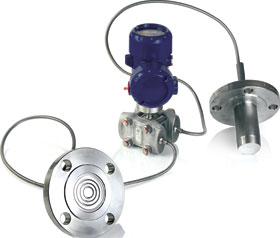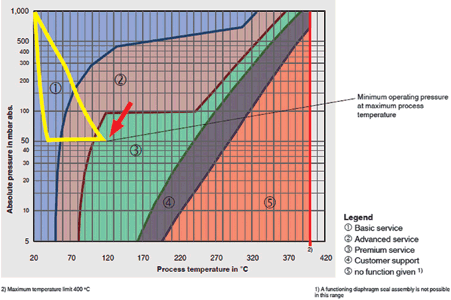

In industry diaphragm seals are primarily used where the medium must not come into contact with the measuring instrument itself. Otherwise corrosive, highly viscous or highly heated media could damage a pressure gauge, pressure transmitter or pressure switch, distort the measuring result and cause additional maintenance and material costs. Diaphragm seals are either mounted directly to the measuring instrument or connected to it via a capillary. The second variant lends itself to unfavourable mounting conditions, where the measuring instrument has insufficient space at the measuring point or is not easily read. It is also suitable for processes with strong vibration.
Regardless of the application, the principle behind a diaphragm seal system remains the same: the process pressure is passed into the diaphragm seal by an elastic diaphragm made of stainless steel, plastic or a special material and transmitted hydraulically to the mechanical or electronic measuring instrument. The appropriate system fill fluid, for example silicone oil, is guided by the process conditions. This is especially true for sensitive processes, such as in the food industry or in the pharmaceutical industry, where any contamination with negative consequences must be eliminated. On the other hand, diaphragm seals prevent toxic media from escaping through any leaks in measuring instruments and harming people and the environment. For anyone needing to fulfil the highest of safety requirements, there are seals with double diaphragms and diaphragm rupture monitoring.
Vacuum processes are more complicated
Diaphragm seal systems deliver safe results with the widest variety of applications. It is somewhat more complicated, however, in vacuum processes, such as those now established in many industrial and biotechnology plants. Where the difficulty lies can be illustrated with the example of a petroleum distillation or rectification plant, where the base material for this process is crude oil. During the process, the individual products are separated by being distilled off at different boiling point ranges (also called fractions). The subsequent processing takes place in two steps: first, the lightly volatile substances are separated at a pressure of at least 1013 mbar abs. Then, the high boiling-point substances are distilled in a vacuum at a pressure of less than 1013 mbar abs. In a vacuum, boiling points can be considerably reduced and thus the destruction of individual compounds due to high temperatures can be prevented.
So during this and similar processes, the temperature rises while the pressure drops. The further apart these diverge, the harder it becomes to configure a working measuring assembly: with decreasing pressure, the boiling point of a liquid drops, and also that of the respective system fill fluid in a diaphragm seal system. The rising temperature, in turn, increases the vapour pressure. With a process pressure lower than 1 bar abs., the operating limits for the individual measuring assemblies therefore decrease.
The evaluation of these limits is a critical issue for pressure measurement. The vapour pressure curves which are supplied by the manufacturers of the system fill fluids are not the ‘Bible’ from which one can derive the required measuring assembly risk-free. Nor does experience on its own guarantee 100% reliability.
In-depth testing yields the answer
WIKA has approached the problem of the uncertainty factor of the system fill fluid via an in-depth series of tests in an external laboratory. The study tested the silicone oils normally used under vacuum conditions, KN 2, KN 17, KN 21 and KN 32 as well as KN 59 (the food-grade Neobee/M20) and KN 92 (medicinal white mineral oil). In an oxygen-free atmosphere, with rising temperature and supplied with energy, the precise decomposition points of the individual media were determined – the points from which their chemical structure was so altered that the molecule chains could no longer be rebuilt. On the basis of the series of experiments described above, the limit ranges for these six oils can now be mapped exactly.
In order to obtain definite conclusions for the operation of the entire measuring assembly in the critical phase of a vacuum process, WIKA followed on from these tests with the inclusion of diaphragm seals and pressure measuring instruments. These results generated charts whose different sections reflect the behaviour of a complete diaphragm seal system at the most critical point – lowest process pressure at the maximum temperature. The individual process ranges define the appropriate measuring assemblies in question.
For the design of the diaphragm seal systems the findings from the behaviour of the system fill fluids needed to be included. In order to make the results for vacuum processes reproducible, automated equipment had to be developed: in the sensitive limit ranges, even one drop too much or too little of the liquid can destabilise the volume balance of the diaphragm seal system and prevent a correct measurement.
Four categories of seal identified
Based on all the studies, WIKA has developed four categories of diaphragm seal systems for vacuum applications. These are made up of three standardised solutions (basic service, advanced service and premium service) and also the possibility for a customer-specific measuring assembly within a narrow special range.
Based on the charts, the user can understand which diaphragm seal system will work the best within the measuring range in a particular process. This can be illustrated by the example in Figure 1: initially the process (yellow line) is at ambient pressure at room temperature. After it starts, the process pressure drops to 50 mbar abs. and the process temperature is driven up to 120°C. Following the final point, the process is reversed until the plant is shut off at ambient pressure and room temperature.

In this example the diaphragm seal system must cover three reaction areas in order to withstand the critical moments in the process. The measuring assembly required for this would be the ‘premium’ category. For such a diaphragm seal, the system fill fluid is conditioned in a special container under laboratory conditions and further processed. The selected measuring instrument is tested for its process suitability prior to mounting and all components are designed for this task. Following the mounting and the final adjustment the complete measuring assembly undergoes a final inspection with the specified process parameters.
All diaphragm seal systems work properly in the designated areas of the chart since they are designed exactly for this. The process safety thus increases and the lifetime of the respective measuring instruments will be extended. Thus the measuring assemblies can also be rated in economic terms.
Where physics sets the limits of the technical possibilities is indicated in section 5 of the charts: A functioning diaphragm seal system is not yet possible in this range.
| Tel: | +27 11 621 0000 |
| Email: | [email protected] |
| www: | www.wika.co.za |
| Articles: | More information and articles about WIKA Instruments |
© Technews Publishing (Pty) Ltd | All Rights Reserved